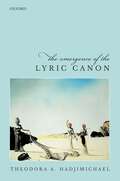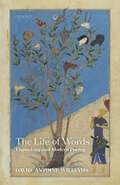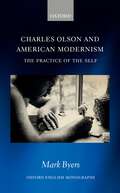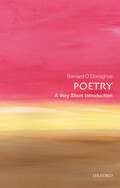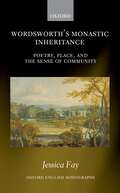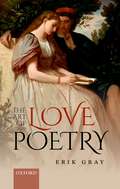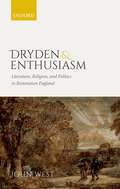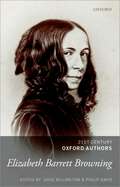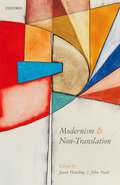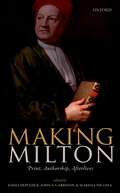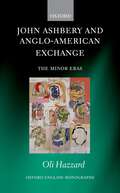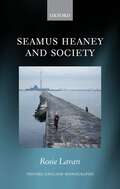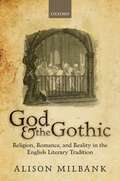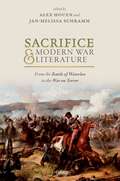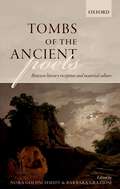- Table View
- List View
The Emergence of the Lyric Canon
by Theodora A. HadjimichaelThe Hellenistic period was an era of literary canons, of privileged texts and collections. One of the most stable of these consisted of the nine (rarely ten) lyric poets: whether the selection was based on poetic quality, popularity, or the availability of texts in the Library of Alexandria, the Lyric Canon offers a valuable and revealing window on the reception and survival of lyric in antiquity. This volume explores the complexities inherent in the process by which lyric poetry was canonized, and discusses questions connected with the textual transmission and preservation of lyric poems from the archaic period through to the Hellenistic era. It firstly contextualizes lyric poetry geographically, and then focuses on a broad range of sources that played a critical role in the survival of lyric poetry - in particular, comedy, Plato, Aristotle's Peripatetic school, and the Hellenistic scholars - to discuss the reception of the nine canonical lyric poets and their work. By exploring the ways in which fifth- and fourth-century sources interpreted lyric material, and the role they played both in the scholarly work of the Alexandrians and in the creation of what we conventionally call the Hellenistic Lyric Canon, it elucidates what can be defined as the prevailing pattern in the transmission of lyric poetry, as well as the place of Bacchylides as a puzzling exception to this norm. The overall discussion conclusively demonstrates that the canonizing process of the lyric poets was already at work from the fifth century BC and that it is reflected both in the evaluation of lyric by fourth-century thinkers and in the activities of the Hellenistic scholars in the Library of Alexandria.
The Life of Words: Etymology and Modern Poetry
by David-Antoine WilliamsFor centuries, investigations into the origins of words were entwined with investigations into the origins of humanity and the cosmos. With the development of modern etymological practice in the nineteenth century, however, many cherished etymologies were shown to be impossible, and the very idea of original 'true meaning' asserted in the etymology of 'etymology' declared a fallacy. Structural linguistics later held that the relationship between sound and meaning in language was 'arbitrary', or 'unmotivated', a truth that has survived with small modification until today. On the other hand, the relationship between sound and meaning has been a prime motivator of poems, at all times throughout history. The Life of Words studies a selection of poets inhabiting our 'Age of the Arbitrary', whose auditory-semantic sensibilities have additionally been motivated by a historical sense of the language, troubled as it may be by claims and counterclaims of 'fallacy' or 'true meaning'. Arguing that etymology activates peculiar kinds of epistemology in the modern poem, the book pays extended attention to poems by G. M. Hopkins, Anne Waldman, Ciaran Carson, and Anne Carson, and to the collected works of Geoffrey Hill, Paul Muldoon, Seamus Heaney, R. F. Langley, and J. H. Prynne.
The Life of Words: Etymology and Modern Poetry
by David-Antoine WilliamsFor centuries, investigations into the origins of words were entwined with investigations into the origins of humanity and the cosmos. With the development of modern etymological practice in the nineteenth century, however, many cherished etymologies were shown to be impossible, and the very idea of original 'true meaning' asserted in the etymology of 'etymology' declared a fallacy. Structural linguistics later held that the relationship between sound and meaning in language was 'arbitrary', or 'unmotivated', a truth that has survived with small modification until today. On the other hand, the relationship between sound and meaning has been a prime motivator of poems, at all times throughout history. The Life of Words studies a selection of poets inhabiting our 'Age of the Arbitrary', whose auditory-semantic sensibilities have additionally been motivated by a historical sense of the language, troubled as it may be by claims and counterclaims of 'fallacy' or 'true meaning'. Arguing that etymology activates peculiar kinds of epistemology in the modern poem, the book pays extended attention to poems by G. M. Hopkins, Anne Waldman, Ciaran Carson, and Anne Carson, and to the collected works of Geoffrey Hill, Paul Muldoon, Seamus Heaney, R. F. Langley, and J. H. Prynne.
Charles Olson and American Modernism: The Practice of the Self (Oxford English Monographs)
by Mark ByersThis volume situates the work of American poet Charles Olson (1910-1970) at the centre of the early post-war American avant-garde. It shows Olson to have been one of the major advocates and theorists of American modernism in the late 1940s and early 1950s; a poet who responded fully and variously to the political, ethical, and aesthetic urgencies driving innovation across contemporary American art. Reading Olson's work alongside that of contemporaries associated with the New York Schools of painting and music (as well as the exiled Frankfurt School), the book draws on Olson's published and unpublished writings to establish an original account of early post-war American modernism. The development of Olson's work is seen to illustrate two primary drivers of formal innovation in the period: the evolution of a new model of political action pivoting around the radical individual and, relatedly, a powerful new critique of instrumental reason and the Enlightenment tradition. Drawing on extensive archival research and featuring readings of a wide range of artists including, prominently, Barnett Newman, Mark Rothko, David Smith, Wolfgang Paalen, and John Cage, Charles Olson and American Modernism offers a new reading of a major American poet and an original account of the emergence of post-war American modernism.
Charles Olson and American Modernism: The Practice of the Self (Oxford English Monographs)
by Mark ByersThis volume situates the work of American poet Charles Olson (1910-1970) at the centre of the early post-war American avant-garde. It shows Olson to have been one of the major advocates and theorists of American modernism in the late 1940s and early 1950s; a poet who responded fully and variously to the political, ethical, and aesthetic urgencies driving innovation across contemporary American art. Reading Olson's work alongside that of contemporaries associated with the New York Schools of painting and music (as well as the exiled Frankfurt School), the book draws on Olson's published and unpublished writings to establish an original account of early post-war American modernism. The development of Olson's work is seen to illustrate two primary drivers of formal innovation in the period: the evolution of a new model of political action pivoting around the radical individual and, relatedly, a powerful new critique of instrumental reason and the Enlightenment tradition. Drawing on extensive archival research and featuring readings of a wide range of artists including, prominently, Barnett Newman, Mark Rothko, David Smith, Wolfgang Paalen, and John Cage, Charles Olson and American Modernism offers a new reading of a major American poet and an original account of the emergence of post-war American modernism.
Poetry: A Very Short Introduction (Very Short Introductions)
by Bernard O'DonoghuePoetry, arguably, has a greater range of conceptual meaning than perhaps any other term in English. At the most basic level everyone can recognise it—it is a kind of literature that uses special linguistic devices of organization and expression for aesthetic effect. However, far grander claims have been made for poetry than this—such as Shelley's that the poets 'are the unacknowledged legislators of the world', and that poetry is 'a higher truth'. In this Very Short Introduction, Bernard O'Donoghue provides a fascinating look at the many different forms of writing which have been called 'poetry'—from the Greeks to the present day. As well as questioning what poetry is, he asks what poetry is for, and considers contemporary debates on its value. Is there a universality to poetry? And does it have a duty of public utility and responsibility? ABOUT THE SERIES: The Very Short Introductions series from Oxford University Press contains hundreds of titles in almost every subject area. These pocket-sized books are the perfect way to get ahead in a new subject quickly. Our expert authors combine facts, analysis, perspective, new ideas, and enthusiasm to make interesting and challenging topics highly readable.
Poetry: Transformation, Reception, Interpretation (Very Short Introductions)
by Bernard O'DonoghuePoetry, arguably, has a greater range of conceptual meaning than perhaps any other term in English. At the most basic level everyone can recognise it—it is a kind of literature that uses special linguistic devices of organization and expression for aesthetic effect. However, far grander claims have been made for poetry than this—such as Shelley's that the poets 'are the unacknowledged legislators of the world', and that poetry is 'a higher truth'. In this Very Short Introduction, Bernard O'Donoghue provides a fascinating look at the many different forms of writing which have been called 'poetry'—from the Greeks to the present day. As well as questioning what poetry is, he asks what poetry is for, and considers contemporary debates on its value. Is there a universality to poetry? And does it have a duty of public utility and responsibility? ABOUT THE SERIES: The Very Short Introductions series from Oxford University Press contains hundreds of titles in almost every subject area. These pocket-sized books are the perfect way to get ahead in a new subject quickly. Our expert authors combine facts, analysis, perspective, new ideas, and enthusiasm to make interesting and challenging topics highly readable.
Wordsworth's Monastic Inheritance: Poetry, Place, and the Sense of Community (Oxford English Monographs)
by Jessica FayThis is the first extended study of Wordsworth's complex, subtle, and often conflicted engagement with the material and cultural legacies of monasticism. It reveals that a set of topographical, antiquarian, and ecclesiastical sources consulted by Wordsworth between 1806 and 1822 provided extensive details of the routines, structures, landscapes, and architecture of the medieval monastic system. In addition to offering a new way of thinking about religious dimensions of Wordsworth's work and his views on Roman Catholicism, the book offers original insights into a range of important issues in his poetry and prose, including the historical resonances of the landscape, local attachment and memorialization, gardening and cultivation, Quakerism and silence, solitude and community, pastoral retreat and national identity. Wordsworth's interest in monastic history helps explain significant stylistic developments in his writing. In this often-neglected phase of his career, Wordsworth undertakes a series of generic experiments in order to craft poems capable of reformulating and refining taste; he adapts popular narrative forms and challenges pastoral conventions, creating difficult, austere poetry that, he hopes, will encourage contemplation and subdue readers' appetites for exciting narrative action. This book thus argues for the significance and innovative qualities of some of Wordsworth's most marginalized writings. It grants poems such as The White Doe of Rylstone, The Excursion, and Ecclesiastical Sketches the centrality Wordsworth believed they deserved, and reveals how Wordsworth's engagement with the monastic history of his local region inflected his radical strategies for the creation of taste.
Wordsworth's Monastic Inheritance: Poetry, Place, and the Sense of Community (Oxford English Monographs)
by Jessica FayThis is the first extended study of Wordsworth's complex, subtle, and often conflicted engagement with the material and cultural legacies of monasticism. It reveals that a set of topographical, antiquarian, and ecclesiastical sources consulted by Wordsworth between 1806 and 1822 provided extensive details of the routines, structures, landscapes, and architecture of the medieval monastic system. In addition to offering a new way of thinking about religious dimensions of Wordsworth's work and his views on Roman Catholicism, the book offers original insights into a range of important issues in his poetry and prose, including the historical resonances of the landscape, local attachment and memorialization, gardening and cultivation, Quakerism and silence, solitude and community, pastoral retreat and national identity. Wordsworth's interest in monastic history helps explain significant stylistic developments in his writing. In this often-neglected phase of his career, Wordsworth undertakes a series of generic experiments in order to craft poems capable of reformulating and refining taste; he adapts popular narrative forms and challenges pastoral conventions, creating difficult, austere poetry that, he hopes, will encourage contemplation and subdue readers' appetites for exciting narrative action. This book thus argues for the significance and innovative qualities of some of Wordsworth's most marginalized writings. It grants poems such as The White Doe of Rylstone, The Excursion, and Ecclesiastical Sketches the centrality Wordsworth believed they deserved, and reveals how Wordsworth's engagement with the monastic history of his local region inflected his radical strategies for the creation of taste.
The Art of Love Poetry
by Erik GrayLove begets poetry; poetry begets love. So thinkers from Plato onwards have claimed; and even today, when poetry has largely disappeared from the mainstream of popular culture, it is still commonly considered the most seductive of all forms of art. But why should this be? What are the connections between poetry and love that lead us to associate them so strongly with one another? In this study Erik Gray draws on a broad range of Western thought and poetry to reveal the qualities and structures that love and poetry share. Above all, he argues, both are founded on paradox. Love is at once necessarily public (because interpersonal) and intensely private; hence love both requires expression and resists it. Likewise the experience of love is simultaneously surprising and familiar, singular and conventional. In poetry, especially lyric poetry - which is similarly both dependent on and resistant to language, both exceptionally regular and exceptionally irregular - love finds a natural outlet. The Art of Love Poetry illuminates many of the recurrent tropes that poets across the centuries have employed to represent and express love, exploring such topics as the poetic kiss, the lyric of conjugal love, and the role of animals in love poetry. In describing the inherent erotics of poetry, it offers new insights not only into the long tradition of love lyric but into the nature of love itself.
Dryden and Enthusiasm: Literature, Religion, and Politics in Restoration England
by John WestIn Dryden's writing, enthusiasm is a source of literary authority. It signals divinely inspired literary creativity. It is central to Dryden's theoretical defences of the relationship between literature and the passions. It is also crucial to his poetic practice in a variety of genres, from odes to religious poems to translations. Enthusiasm, for Dryden, ultimately enables literature to break into regions of knowledge beyond rational human comprehension. Yet after the rise of radical sectarianism in the 1640s and 1650s, where claims of inspiration legitimised challenges to established political authority, enthusiasm also carried dangerous theological and political connotations. In Dryden's writing, enthusiasm is thus also a pejorative term. It is used to attack political radicals and religious dissenters. In the aftermath of the Civil Wars, it is at the root of many perceived threats to the stability of the Restoration state. This book explores the paradoxical place of enthusiasm in Dryden's writing and the role he conceived for it in art and society after the violent upheavals of the mid seventeenth century. Works from across his oeuvre are explored, from his early essays and heroic plays to his translations, via new readings of his famous political and religious poems. These are read alongside other major writers of the period, like Milton, and less well-known authors, such as John Dennis. The book suggests new ways of conceptualising the relationship between literary practice and ideological allegiance in Restoration England. It reveals Dryden to be a writer who was consistently interested in the limits of what literature could express, what feelings it could provoke, and what it could make people believe at a time when such questions were of uncertain political importance.
Dryden and Enthusiasm: Literature, Religion, and Politics in Restoration England
by John WestIn Dryden's writing, enthusiasm is a source of literary authority. It signals divinely inspired literary creativity. It is central to Dryden's theoretical defences of the relationship between literature and the passions. It is also crucial to his poetic practice in a variety of genres, from odes to religious poems to translations. Enthusiasm, for Dryden, ultimately enables literature to break into regions of knowledge beyond rational human comprehension. Yet after the rise of radical sectarianism in the 1640s and 1650s, where claims of inspiration legitimised challenges to established political authority, enthusiasm also carried dangerous theological and political connotations. In Dryden's writing, enthusiasm is thus also a pejorative term. It is used to attack political radicals and religious dissenters. In the aftermath of the Civil Wars, it is at the root of many perceived threats to the stability of the Restoration state. This book explores the paradoxical place of enthusiasm in Dryden's writing and the role he conceived for it in art and society after the violent upheavals of the mid seventeenth century. Works from across his oeuvre are explored, from his early essays and heroic plays to his translations, via new readings of his famous political and religious poems. These are read alongside other major writers of the period, like Milton, and less well-known authors, such as John Dennis. The book suggests new ways of conceptualising the relationship between literary practice and ideological allegiance in Restoration England. It reveals Dryden to be a writer who was consistently interested in the limits of what literature could express, what feelings it could provoke, and what it could make people believe at a time when such questions were of uncertain political importance.
Elizabeth Barrett Browning: Selected Writings (21st-Century Oxford Authors)
This volume in the 21st Century Oxford Authors series offers students and readers a comprehensive selection of the work of the poet Elizabeth Barrett Browning (1806-1861). Accompanied by full scholarly apparatus, this authoritative edition enables students to study Barrett Browning's work within the rich context of her life and writing career. The revaluation of Elizabeth Barrett Browning's work by feminist scholars has made her an established author in university syllabuses in Britain and in America. Yet the reception of Barrett Browning as a writer within an explicitly female tradition has tended to limit the appreciation of her wider contribution to English literary culture in the nineteenth century, just as her popular image as a ringleted romantic heroine served sentimentally to eclipse her role as a literary pioneer. This edition complements or corrects these emphases by being the first edition dedicated to witnessing the progress and growth of the poet's creative direction—from her juvenilia through to her major achievements and beyond. The selection of works presented here appear in the order in which they were originally published, enabling students and readers to experience the contours of Barrett Browning's poetic career. Thus, following selections from published juvenilia, The Battle of Marathon (1820) and 'An Essay on Mind' and Other Poems (1826) and from 'Prometheus Bound' and Miscellaneous Poems (1833), there are more extensive selections from 'The Seraphim' and Other Poems (1838), from Poems 1844 and from Poems 1850 including the full text of Sonnets from the Portuguese. Substantial excerpts from Casa Guidi Windows (1851) is followed by the full text of Aurora Leigh (1857) and by selections from the posthumous Last Poems (1862). These individual sections are supplemented by careful selections (also chronologically ordered) from the correspondence, including the courtship letters with Robert Browning, and, where applicable, from poetry unpublished in the nineteenth century. Explanatory notes and commentary are included, to enhance the study, understanding, and enjoyment of these works, and the edition includes an Introduction to the life and works of Barrett Browning, and a Chronology.
Modernism and Non-Translation
This book explores the incorporation of untranslated fragments from various languages within modernist writing. It studies non-translation in modernist fiction, poetry, and other forms of writing, with a principally European focus and addresses the following questions: what are the aesthetic and cultural implications of non-translation for modernist literature? How did non-translation shape the poetics, and cultural politics, of some of the most important writers of this key period? This edited volume, written by leading scholars of modernism, explores American, British, and Irish texts, alongside major French and German writers and the wider modernist recovery of Classical languages. The chapters analyse non-translation from the dual perspectives of both 'insider' and 'outsider', unsettling that false opposition and articulating in the process their individuality of expression and experience. The range of voices explored indicates something of the reach and vitality of the matter of translation—and specifically non-translation—across a selection of poetry, fiction, and non-fictional prose, while focusing on mainly canonical voices. Together, these essays seek to provoke and extend debate on the aesthetic, cultural, political, and conceptual dimensions of non-translation as an important yet hitherto neglected facet of modernism, thus helping to re-define our understanding of that movement. It demonstrates the rich possibilities of reading modernism through instances of non-translation.
Modernism and Non-Translation
by Jason Harding John NashThis book explores the incorporation of untranslated fragments from various languages within modernist writing. It studies non-translation in modernist fiction, poetry, and other forms of writing, with a principally European focus and addresses the following questions: what are the aesthetic and cultural implications of non-translation for modernist literature? How did non-translation shape the poetics, and cultural politics, of some of the most important writers of this key period? This edited volume, written by leading scholars of modernism, explores American, British, and Irish texts, alongside major French and German writers and the wider modernist recovery of Classical languages. The chapters analyse non-translation from the dual perspectives of both 'insider' and 'outsider', unsettling that false opposition and articulating in the process their individuality of expression and experience. The range of voices explored indicates something of the reach and vitality of the matter of translation—and specifically non-translation—across a selection of poetry, fiction, and non-fictional prose, while focusing on mainly canonical voices. Together, these essays seek to provoke and extend debate on the aesthetic, cultural, political, and conceptual dimensions of non-translation as an important yet hitherto neglected facet of modernism, thus helping to re-define our understanding of that movement. It demonstrates the rich possibilities of reading modernism through instances of non-translation.
Making Milton: Print, Authorship, Afterlives
This volume consists of fourteen original essays that showcase the latest thinking about John Milton's emergence as a popular and canonical author. Contributors consider how Milton positioned himself in relation to the book trade, contemporaneous thinkers, and intellectual movements, as well as how his works have been positioned since their first publication. The individual chapters assess Milton's reception by exploring how his authorial persona was shaped by the modes of writing in which he chose to express himself, the material forms in which his works circulated, and the ways in which his texts were re-appropriated by later writers. The Milton that emerges is one who actively fashioned his reputation by carefully selecting his modes of writing, his language of composition, and the stationers with whom he collaborated. Throughout the volume, contributors also demonstrate the profound impact Milton and his works have had on the careers of a variety of agents, from publishers, booksellers, and fellow writers to colonizers in Mexico and South America.
Making Milton: Print, Authorship, Afterlives
by John S. Garrison Emma Depledge Marissa NicosiaThis volume consists of fourteen original essays that showcase the latest thinking about John Milton's emergence as a popular and canonical author. Contributors consider how Milton positioned himself in relation to the book trade, contemporaneous thinkers, and intellectual movements, as well as how his works have been positioned since their first publication. The individual chapters assess Milton's reception by exploring how his authorial persona was shaped by the modes of writing in which he chose to express himself, the material forms in which his works circulated, and the ways in which his texts were re-appropriated by later writers. The Milton that emerges is one who actively fashioned his reputation by carefully selecting his modes of writing, his language of composition, and the stationers with whom he collaborated. Throughout the volume, contributors also demonstrate the profound impact Milton and his works have had on the careers of a variety of agents, from publishers, booksellers, and fellow writers to colonizers in Mexico and South America.
John Ashbery and Anglo-American Exchange: The Minor Eras (Oxford English Monographs)
by Oli HazzardIn 1966, John Ashbery wrote: 'The English language is constantly trying to stave off invasion by the American language; it lives in a state of alert which is reflected to some degree in English poetry.' This book shows how the work of a major post-war American poet has been centrally concerned with questions of national identity and intercultural poetic exchange, by reading crucial episodes in Ashbery's oeuvre in the context of an 'other tradition' of modern English poets he himself has defined. This line runs from the editor of Ashbery's recent Collected Poems, Mark Ford, through Lee Harwood in the late 1960s, F. T. Prince in the 1950s, to 'chronologically the first and therefore most important influence' on his own work, W. H. Auden. Through detailed close readings of the poetry of Ashbery and these English poets, original interviews, and extensive archival research, a new account of Ashbery's aesthetic, and a significant re-mapping of post-war English poetry, is presented. The biographical slant of the book is highly significant, as it reads these writers' poetry and correspondence together for the first time, suggesting how major poetic innovations arose from specific social contexts, from the particulars of relations between poets, and also from a broader climate of Anglo-American exchange as registered by each poet. The book's presentation of the process of poetic influence is attentive to actual exchanges between contemporaries as evidenced in correspondence, as opposed to speculative relationships with dominant figures, and as such represents a departure from many other studies of Ashbery's work. Key themes include 'Englishness' as a national imaginary, the concept of the 'minor', reciprocal influence, and the poetry of coteries. The result is that both Ashbery himself, and the landscape of post-war English poetry, are presented in significantly new lights.
John Ashbery and Anglo-American Exchange: The Minor Eras (Oxford English Monographs)
by Oli HazzardIn 1966, John Ashbery wrote: 'The English language is constantly trying to stave off invasion by the American language; it lives in a state of alert which is reflected to some degree in English poetry.' This book shows how the work of a major post-war American poet has been centrally concerned with questions of national identity and intercultural poetic exchange, by reading crucial episodes in Ashbery's oeuvre in the context of an 'other tradition' of modern English poets he himself has defined. This line runs from the editor of Ashbery's recent Collected Poems, Mark Ford, through Lee Harwood in the late 1960s, F. T. Prince in the 1950s, to 'chronologically the first and therefore most important influence' on his own work, W. H. Auden. Through detailed close readings of the poetry of Ashbery and these English poets, original interviews, and extensive archival research, a new account of Ashbery's aesthetic, and a significant re-mapping of post-war English poetry, is presented. The biographical slant of the book is highly significant, as it reads these writers' poetry and correspondence together for the first time, suggesting how major poetic innovations arose from specific social contexts, from the particulars of relations between poets, and also from a broader climate of Anglo-American exchange as registered by each poet. The book's presentation of the process of poetic influence is attentive to actual exchanges between contemporaries as evidenced in correspondence, as opposed to speculative relationships with dominant figures, and as such represents a departure from many other studies of Ashbery's work. Key themes include 'Englishness' as a national imaginary, the concept of the 'minor', reciprocal influence, and the poetry of coteries. The result is that both Ashbery himself, and the landscape of post-war English poetry, are presented in significantly new lights.
Seamus Heaney and Society (Oxford English Monographs)
by Rosie LavanThroughout his career in poetry, Seamus Heaney maintained roles in education and was a visible presence in the print and broadcast media. Seamus Heaney and Society presents a dynamic new engagement with one of the most celebrated poets of the modern period, examining the ways in which his work as a poet was shaped by his work as a teacher, lecturer, critic, and public figure. Drawing on a range of archival material, this book revives the varied contexts within which Heaney's work was written, published, and circulated. Mindful of the different spheres which surrounded his pursuit of poetry, it assesses his achievements and status in Ireland, Britain, and the United States through close analysis of his work in newspapers, magazines, radio, and television, and manuscript drafts of key writings now held in the National Library of Ireland. Asserting the significance of the cultural, institutional, and historical worlds in which Heaney wrote and was read, Seamus Heaney and Society offers a timely reconstruction of the social lives of his work, while also exploring the ways in which he questioned and sustained the privacy and singularity of poetry. Ultimately, it considers how the enduring legacy of a great poet emerges from the working life of a contemporary writer.
Seamus Heaney and Society (Oxford English Monographs)
by Rosie LavanThroughout his career in poetry, Seamus Heaney maintained roles in education and was a visible presence in the print and broadcast media. Seamus Heaney and Society presents a dynamic new engagement with one of the most celebrated poets of the modern period, examining the ways in which his work as a poet was shaped by his work as a teacher, lecturer, critic, and public figure. Drawing on a range of archival material, this book revives the varied contexts within which Heaney's work was written, published, and circulated. Mindful of the different spheres which surrounded his pursuit of poetry, it assesses his achievements and status in Ireland, Britain, and the United States through close analysis of his work in newspapers, magazines, radio, and television, and manuscript drafts of key writings now held in the National Library of Ireland. Asserting the significance of the cultural, institutional, and historical worlds in which Heaney wrote and was read, Seamus Heaney and Society offers a timely reconstruction of the social lives of his work, while also exploring the ways in which he questioned and sustained the privacy and singularity of poetry. Ultimately, it considers how the enduring legacy of a great poet emerges from the working life of a contemporary writer.
God & the Gothic: Religion, Romance, & Reality in the English Literary Tradition
by Alison MilbankGod and the Gothic: Romance and Reality in the English Literary Tradition provides a complete reimagining of the Gothic literary canon to examine its engagement with theological ideas, tracing its origins to the apocalyptic critique of the Reformation female martyrs, and to the Dissolution of the monasteries, now seen as usurping authorities. A double gesture of repudiation and regret is evident in the consequent search for political, aesthetic, and religious mediation, which characterizes the aftermath of the Glorious Revolution and Whig Providential discourse. Part one interprets eighteenth-century Gothic novels in terms of this Whig debate about the true heir, culminating in Ann Radcliffe's melancholic theology which uses distance and loss to enable a new mediation. Part two traces the origins of the doppelgänger in Calvinist anthropology and establishes that its employment by a range of Scottish writers offers a productive mode of subjectivity, necessary in a culture equally concerned with historical continuity. In part three, Irish Gothic is shown to be seeking ways to mediate between Catholic and Protestant identities through models of sacrifice and ecumenism, while in part four nineteenth-century Gothic is read as increasingly theological, responding to materialism by a project of re-enchantment. Ghost story writers assert the metaphysical priority of the supernatural to establish the material world. Arthur Machen and other Order of the Golden Dawn members explore the double and other Gothic tropes as modes of mystical ascent, while raising the physical to the spiritual through magical control, and the M. R. James circle restore the sacramental and psychical efficacy of objects.
God & the Gothic: Religion, Romance, & Reality in the English Literary Tradition
by Alison MilbankGod and the Gothic: Romance and Reality in the English Literary Tradition provides a complete reimagining of the Gothic literary canon to examine its engagement with theological ideas, tracing its origins to the apocalyptic critique of the Reformation female martyrs, and to the Dissolution of the monasteries, now seen as usurping authorities. A double gesture of repudiation and regret is evident in the consequent search for political, aesthetic, and religious mediation, which characterizes the aftermath of the Glorious Revolution and Whig Providential discourse. Part one interprets eighteenth-century Gothic novels in terms of this Whig debate about the true heir, culminating in Ann Radcliffe's melancholic theology which uses distance and loss to enable a new mediation. Part two traces the origins of the doppelgänger in Calvinist anthropology and establishes that its employment by a range of Scottish writers offers a productive mode of subjectivity, necessary in a culture equally concerned with historical continuity. In part three, Irish Gothic is shown to be seeking ways to mediate between Catholic and Protestant identities through models of sacrifice and ecumenism, while in part four nineteenth-century Gothic is read as increasingly theological, responding to materialism by a project of re-enchantment. Ghost story writers assert the metaphysical priority of the supernatural to establish the material world. Arthur Machen and other Order of the Golden Dawn members explore the double and other Gothic tropes as modes of mystical ascent, while raising the physical to the spiritual through magical control, and the M. R. James circle restore the sacramental and psychical efficacy of objects.
Sacrifice and Modern War Literature: The Battle of Waterloo to the War on Terror
by Jan-Melissa Schramm Alex HouenSacrifice and Modern War Literature is the first book to explore how writers from the early nineteenth century to the present have addressed the intimacy of sacrifice and war. It has been common for critics to argue that after the First World War many of the cultural and religious values associated with sacrifice have been increasingly rejected by writers and others. However, this volume shows that literature has continued to address how different conceptions of sacrifice have been invoked in times of war to convert losses into gains or ideals. While those conceptions have sometimes been rooted in a secular rationalism that values lost lives in terms of political or national victories, spiritual and religious conceptions of sacrifice are also still in evidence, as with the 'martyrdom operations' of jihadis fighting against the 'war on terror'. Each chapter presents fresh insights into the literature of a particular conflict and the contributions explore major war writers including Wordsworth, Kipling, Ford Madox Ford, and Elizabeth Bowen, as well as lesser known authors such as Dora Sigerson, Richard Aldington, Thomas Kinsella, and Nadeem Aslam. The volume covers multiple genres including novels, poetry (particularly elegy and lyric), memoirs, and some films. The contributions address a rich array of topics related to wartime sacrifice including scapegoating, martyrdom, religious faith, tragedy, heroism, altruism, 'bare life', atonement, and redemption.
Tombs of the Ancient Poets: Between Literary Reception and Material Culture
Tombs of the Ancient Poets explores the ways in which the tombs of the ancient poets - real or imagined - act as crucial sites for the reception of Greek and Latin poetry. Drawing together a range of examples, it makes a distinctive contribution to the study of literary reception by focusing on the materiality of the body and the tomb, and the ways in which they mediate the relationship between classical poetry and its readers. From the tomb of the boy poet Quintus Sulpicius Maximus, which preserves his prize-winning poetry carved on the tombstone itself, to the modern votive offerings left at the so-called 'Tomb of Virgil'; from the doomed tomb-hunting of long-lost poets' graves, to the 'graveyard of the imagination' constructed in Hellenistic poetry collections, the essays collected here explore the position of ancient poets' tombs in the cultural imagination and demonstrate the rich variety of ways in which they exemplify an essential mode of the reception of ancient poetry, poised as they are between literary reception and material culture.
